Reflection on Trauma Informed Care Process in Nursing Practice
VerifiedAdded on 2020/04/01
|8
|2930
|497
Essay
AI Summary
This essay provides a comprehensive reflection on trauma-informed care within the context of nursing practice. It begins by defining trauma-informed care and its emphasis on physical, psychological, and responsive aspects of health and safety, highlighting its importance in supporting both survivors and healthcare providers. The essay then explores the impact of trauma-informed care at the policy level, emphasizing the shift towards recovery-oriented approaches and the development of policies to improve mental health services. It examines the implementation of trauma-informed care in various settings, including inpatient, psychiatric, and paediatric settings, and discusses the effects of these practices on patient outcomes. Furthermore, the essay reflects on the six core principles of trauma-informed care, including safety, trustworthiness, choice, collaboration, and empowerment, and how these principles are applied in nursing practice to enhance patient care. The conclusion emphasizes the fundamental impact of trauma-informed care on contemporary nursing practice and the importance of understanding trauma to effectively support patients.
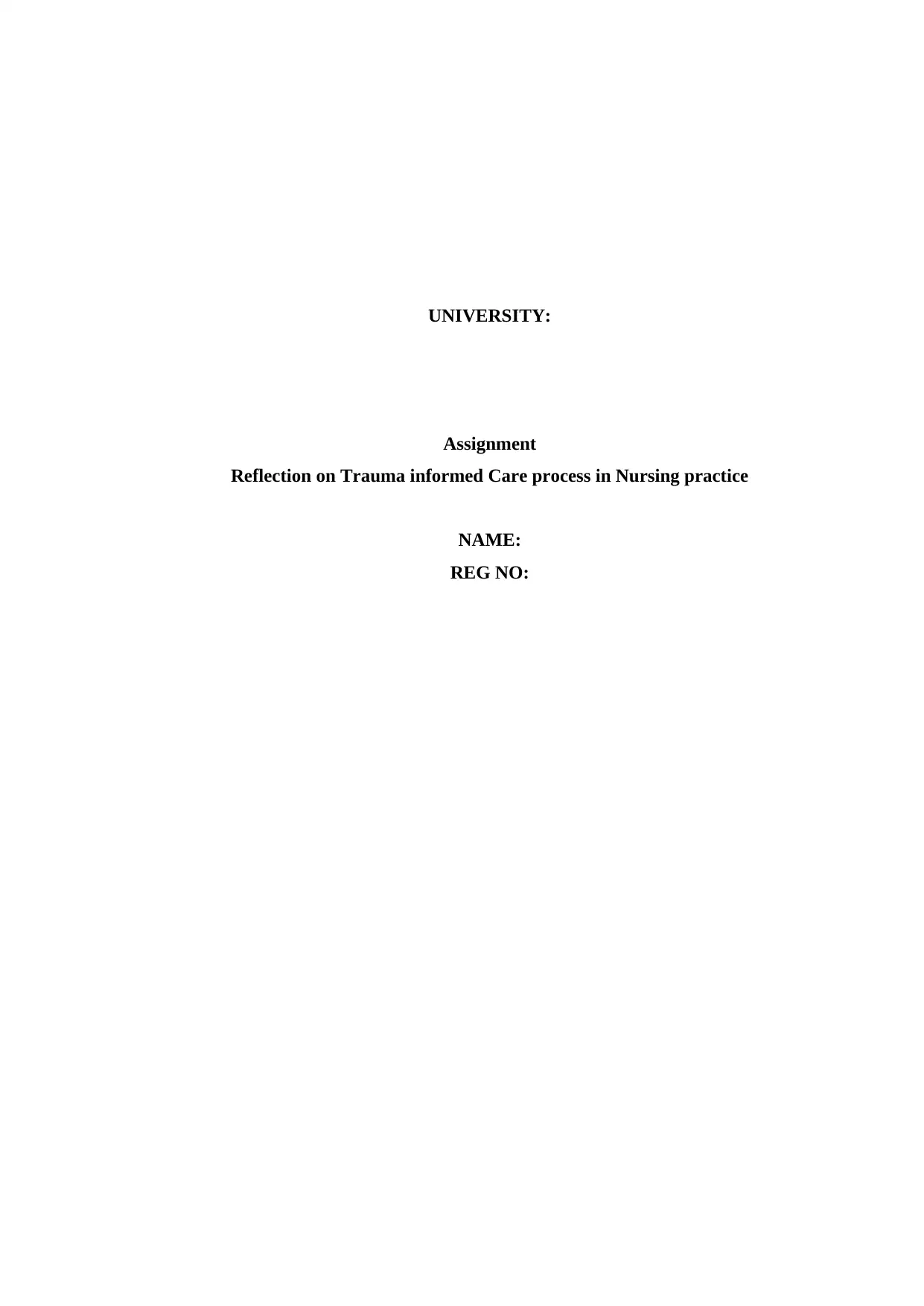
UNIVERSITY:
Assignment
Reflection on Trauma informed Care process in Nursing practice
NAME:
REG NO:
Assignment
Reflection on Trauma informed Care process in Nursing practice
NAME:
REG NO:
Paraphrase This Document
Need a fresh take? Get an instant paraphrase of this document with our AI Paraphraser
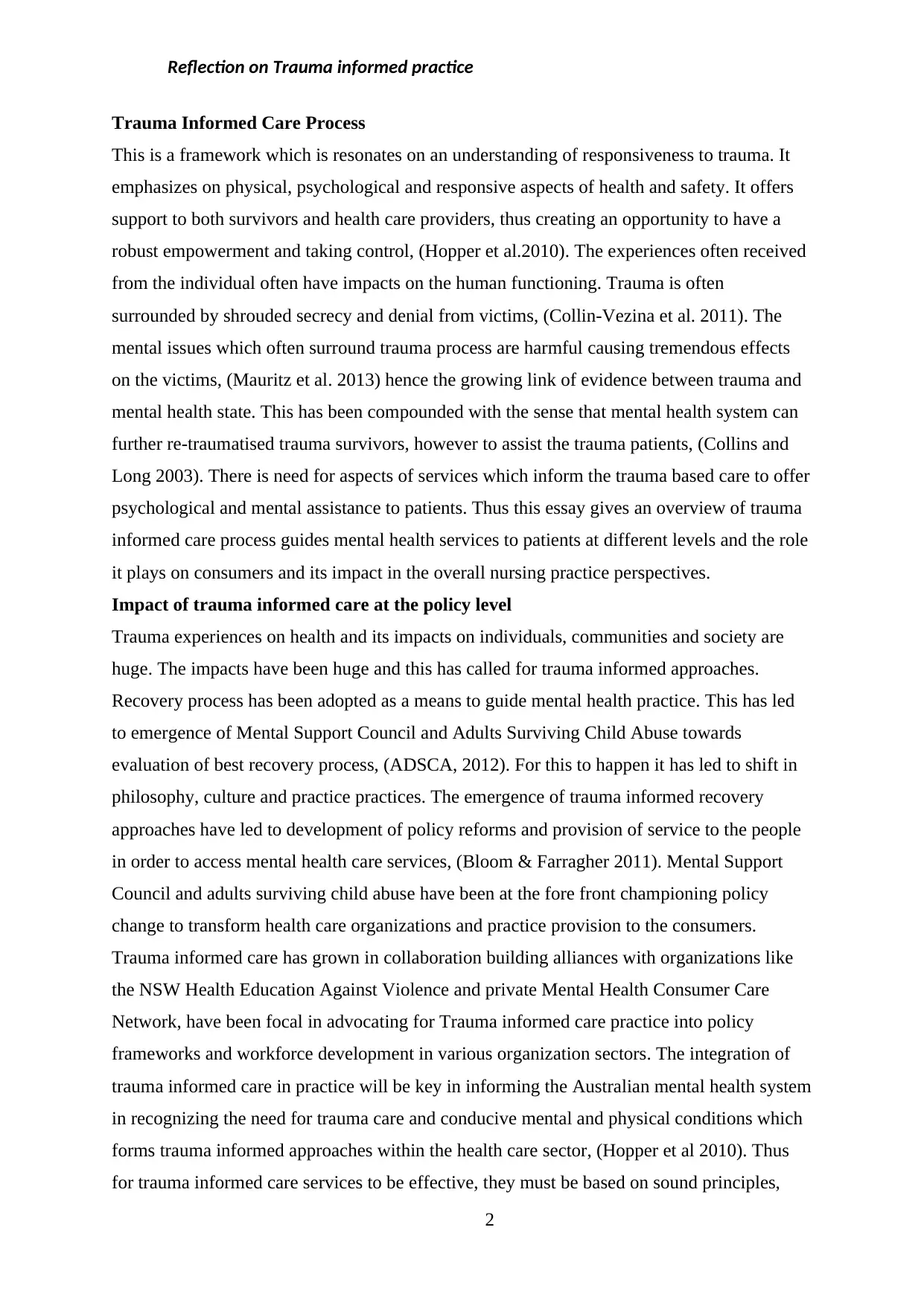
Reflection on Trauma informed practice
Trauma Informed Care Process
This is a framework which is resonates on an understanding of responsiveness to trauma. It
emphasizes on physical, psychological and responsive aspects of health and safety. It offers
support to both survivors and health care providers, thus creating an opportunity to have a
robust empowerment and taking control, (Hopper et al.2010). The experiences often received
from the individual often have impacts on the human functioning. Trauma is often
surrounded by shrouded secrecy and denial from victims, (Collin-Vezina et al. 2011). The
mental issues which often surround trauma process are harmful causing tremendous effects
on the victims, (Mauritz et al. 2013) hence the growing link of evidence between trauma and
mental health state. This has been compounded with the sense that mental health system can
further re-traumatised trauma survivors, however to assist the trauma patients, (Collins and
Long 2003). There is need for aspects of services which inform the trauma based care to offer
psychological and mental assistance to patients. Thus this essay gives an overview of trauma
informed care process guides mental health services to patients at different levels and the role
it plays on consumers and its impact in the overall nursing practice perspectives.
Impact of trauma informed care at the policy level
Trauma experiences on health and its impacts on individuals, communities and society are
huge. The impacts have been huge and this has called for trauma informed approaches.
Recovery process has been adopted as a means to guide mental health practice. This has led
to emergence of Mental Support Council and Adults Surviving Child Abuse towards
evaluation of best recovery process, (ADSCA, 2012). For this to happen it has led to shift in
philosophy, culture and practice practices. The emergence of trauma informed recovery
approaches have led to development of policy reforms and provision of service to the people
in order to access mental health care services, (Bloom & Farragher 2011). Mental Support
Council and adults surviving child abuse have been at the fore front championing policy
change to transform health care organizations and practice provision to the consumers.
Trauma informed care has grown in collaboration building alliances with organizations like
the NSW Health Education Against Violence and private Mental Health Consumer Care
Network, have been focal in advocating for Trauma informed care practice into policy
frameworks and workforce development in various organization sectors. The integration of
trauma informed care in practice will be key in informing the Australian mental health system
in recognizing the need for trauma care and conducive mental and physical conditions which
forms trauma informed approaches within the health care sector, (Hopper et al 2010). Thus
for trauma informed care services to be effective, they must be based on sound principles,
2
Trauma Informed Care Process
This is a framework which is resonates on an understanding of responsiveness to trauma. It
emphasizes on physical, psychological and responsive aspects of health and safety. It offers
support to both survivors and health care providers, thus creating an opportunity to have a
robust empowerment and taking control, (Hopper et al.2010). The experiences often received
from the individual often have impacts on the human functioning. Trauma is often
surrounded by shrouded secrecy and denial from victims, (Collin-Vezina et al. 2011). The
mental issues which often surround trauma process are harmful causing tremendous effects
on the victims, (Mauritz et al. 2013) hence the growing link of evidence between trauma and
mental health state. This has been compounded with the sense that mental health system can
further re-traumatised trauma survivors, however to assist the trauma patients, (Collins and
Long 2003). There is need for aspects of services which inform the trauma based care to offer
psychological and mental assistance to patients. Thus this essay gives an overview of trauma
informed care process guides mental health services to patients at different levels and the role
it plays on consumers and its impact in the overall nursing practice perspectives.
Impact of trauma informed care at the policy level
Trauma experiences on health and its impacts on individuals, communities and society are
huge. The impacts have been huge and this has called for trauma informed approaches.
Recovery process has been adopted as a means to guide mental health practice. This has led
to emergence of Mental Support Council and Adults Surviving Child Abuse towards
evaluation of best recovery process, (ADSCA, 2012). For this to happen it has led to shift in
philosophy, culture and practice practices. The emergence of trauma informed recovery
approaches have led to development of policy reforms and provision of service to the people
in order to access mental health care services, (Bloom & Farragher 2011). Mental Support
Council and adults surviving child abuse have been at the fore front championing policy
change to transform health care organizations and practice provision to the consumers.
Trauma informed care has grown in collaboration building alliances with organizations like
the NSW Health Education Against Violence and private Mental Health Consumer Care
Network, have been focal in advocating for Trauma informed care practice into policy
frameworks and workforce development in various organization sectors. The integration of
trauma informed care in practice will be key in informing the Australian mental health system
in recognizing the need for trauma care and conducive mental and physical conditions which
forms trauma informed approaches within the health care sector, (Hopper et al 2010). Thus
for trauma informed care services to be effective, they must be based on sound principles,
2
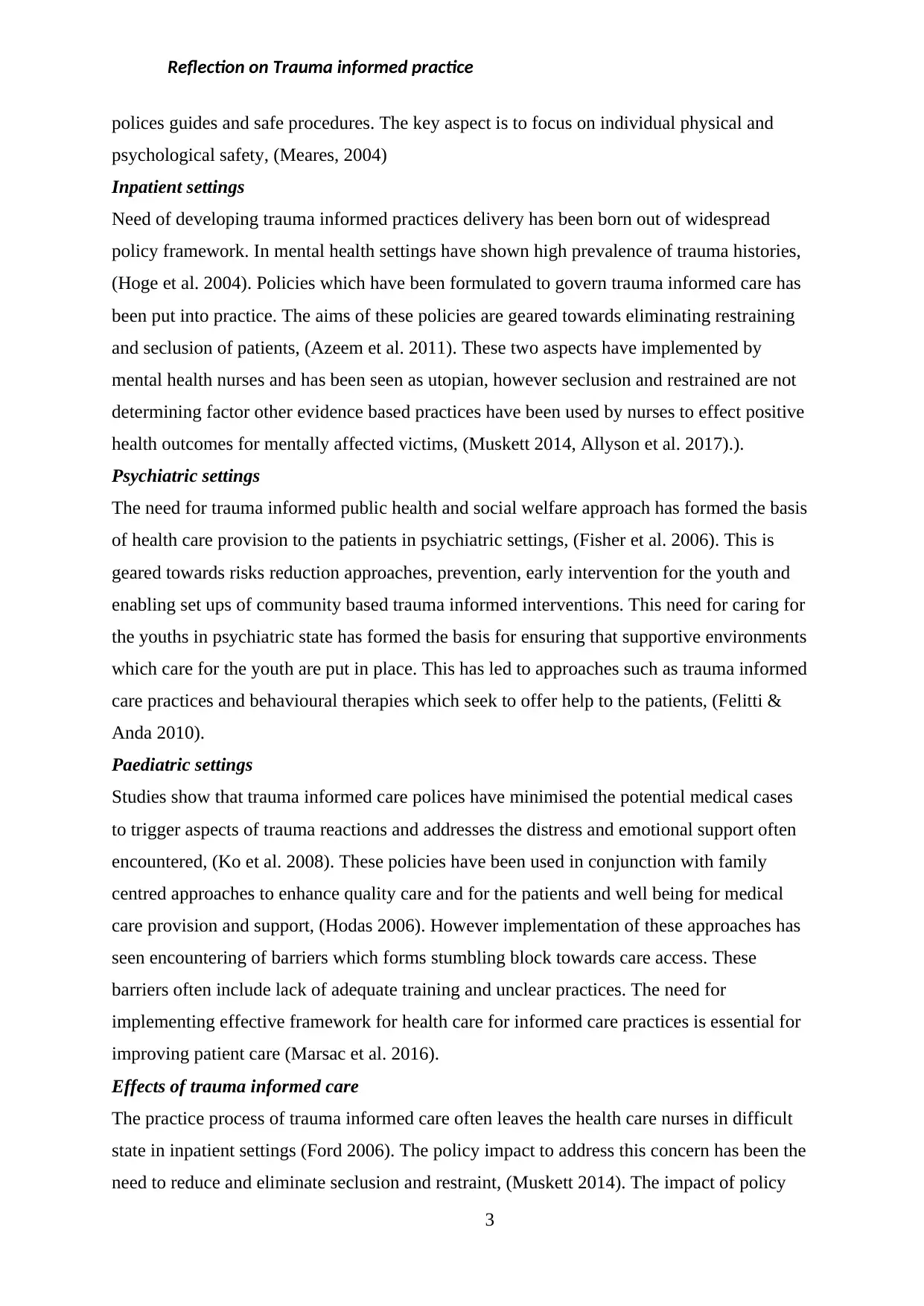
Reflection on Trauma informed practice
polices guides and safe procedures. The key aspect is to focus on individual physical and
psychological safety, (Meares, 2004)
Inpatient settings
Need of developing trauma informed practices delivery has been born out of widespread
policy framework. In mental health settings have shown high prevalence of trauma histories,
(Hoge et al. 2004). Policies which have been formulated to govern trauma informed care has
been put into practice. The aims of these policies are geared towards eliminating restraining
and seclusion of patients, (Azeem et al. 2011). These two aspects have implemented by
mental health nurses and has been seen as utopian, however seclusion and restrained are not
determining factor other evidence based practices have been used by nurses to effect positive
health outcomes for mentally affected victims, (Muskett 2014, Allyson et al. 2017).).
Psychiatric settings
The need for trauma informed public health and social welfare approach has formed the basis
of health care provision to the patients in psychiatric settings, (Fisher et al. 2006). This is
geared towards risks reduction approaches, prevention, early intervention for the youth and
enabling set ups of community based trauma informed interventions. This need for caring for
the youths in psychiatric state has formed the basis for ensuring that supportive environments
which care for the youth are put in place. This has led to approaches such as trauma informed
care practices and behavioural therapies which seek to offer help to the patients, (Felitti &
Anda 2010).
Paediatric settings
Studies show that trauma informed care polices have minimised the potential medical cases
to trigger aspects of trauma reactions and addresses the distress and emotional support often
encountered, (Ko et al. 2008). These policies have been used in conjunction with family
centred approaches to enhance quality care and for the patients and well being for medical
care provision and support, (Hodas 2006). However implementation of these approaches has
seen encountering of barriers which forms stumbling block towards care access. These
barriers often include lack of adequate training and unclear practices. The need for
implementing effective framework for health care for informed care practices is essential for
improving patient care (Marsac et al. 2016).
Effects of trauma informed care
The practice process of trauma informed care often leaves the health care nurses in difficult
state in inpatient settings (Ford 2006). The policy impact to address this concern has been the
need to reduce and eliminate seclusion and restraint, (Muskett 2014). The impact of policy
3
polices guides and safe procedures. The key aspect is to focus on individual physical and
psychological safety, (Meares, 2004)
Inpatient settings
Need of developing trauma informed practices delivery has been born out of widespread
policy framework. In mental health settings have shown high prevalence of trauma histories,
(Hoge et al. 2004). Policies which have been formulated to govern trauma informed care has
been put into practice. The aims of these policies are geared towards eliminating restraining
and seclusion of patients, (Azeem et al. 2011). These two aspects have implemented by
mental health nurses and has been seen as utopian, however seclusion and restrained are not
determining factor other evidence based practices have been used by nurses to effect positive
health outcomes for mentally affected victims, (Muskett 2014, Allyson et al. 2017).).
Psychiatric settings
The need for trauma informed public health and social welfare approach has formed the basis
of health care provision to the patients in psychiatric settings, (Fisher et al. 2006). This is
geared towards risks reduction approaches, prevention, early intervention for the youth and
enabling set ups of community based trauma informed interventions. This need for caring for
the youths in psychiatric state has formed the basis for ensuring that supportive environments
which care for the youth are put in place. This has led to approaches such as trauma informed
care practices and behavioural therapies which seek to offer help to the patients, (Felitti &
Anda 2010).
Paediatric settings
Studies show that trauma informed care polices have minimised the potential medical cases
to trigger aspects of trauma reactions and addresses the distress and emotional support often
encountered, (Ko et al. 2008). These policies have been used in conjunction with family
centred approaches to enhance quality care and for the patients and well being for medical
care provision and support, (Hodas 2006). However implementation of these approaches has
seen encountering of barriers which forms stumbling block towards care access. These
barriers often include lack of adequate training and unclear practices. The need for
implementing effective framework for health care for informed care practices is essential for
improving patient care (Marsac et al. 2016).
Effects of trauma informed care
The practice process of trauma informed care often leaves the health care nurses in difficult
state in inpatient settings (Ford 2006). The policy impact to address this concern has been the
need to reduce and eliminate seclusion and restraint, (Muskett 2014). The impact of policy
3
⊘ This is a preview!⊘
Do you want full access?
Subscribe today to unlock all pages.

Trusted by 1+ million students worldwide
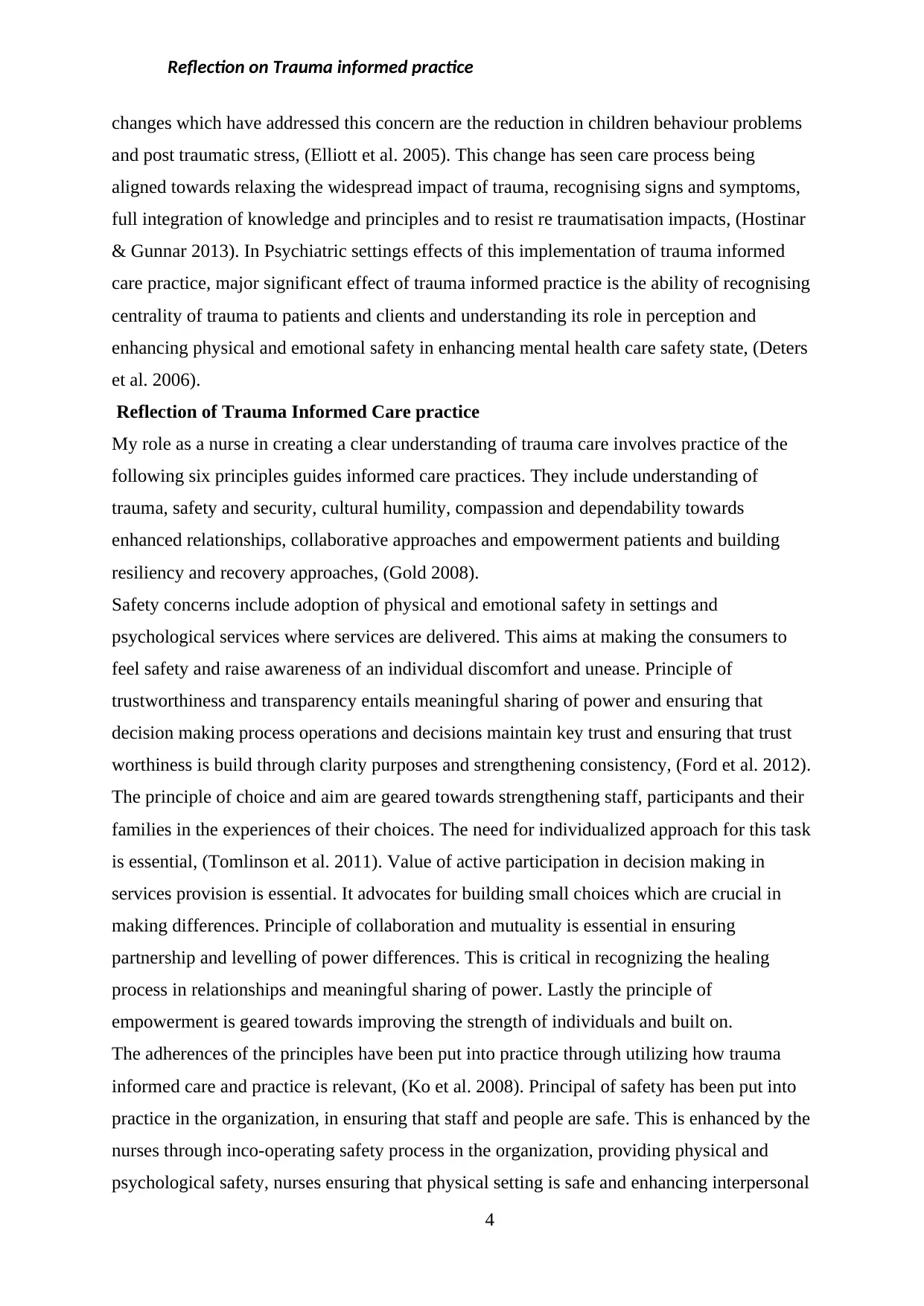
Reflection on Trauma informed practice
changes which have addressed this concern are the reduction in children behaviour problems
and post traumatic stress, (Elliott et al. 2005). This change has seen care process being
aligned towards relaxing the widespread impact of trauma, recognising signs and symptoms,
full integration of knowledge and principles and to resist re traumatisation impacts, (Hostinar
& Gunnar 2013). In Psychiatric settings effects of this implementation of trauma informed
care practice, major significant effect of trauma informed practice is the ability of recognising
centrality of trauma to patients and clients and understanding its role in perception and
enhancing physical and emotional safety in enhancing mental health care safety state, (Deters
et al. 2006).
Reflection of Trauma Informed Care practice
My role as a nurse in creating a clear understanding of trauma care involves practice of the
following six principles guides informed care practices. They include understanding of
trauma, safety and security, cultural humility, compassion and dependability towards
enhanced relationships, collaborative approaches and empowerment patients and building
resiliency and recovery approaches, (Gold 2008).
Safety concerns include adoption of physical and emotional safety in settings and
psychological services where services are delivered. This aims at making the consumers to
feel safety and raise awareness of an individual discomfort and unease. Principle of
trustworthiness and transparency entails meaningful sharing of power and ensuring that
decision making process operations and decisions maintain key trust and ensuring that trust
worthiness is build through clarity purposes and strengthening consistency, (Ford et al. 2012).
The principle of choice and aim are geared towards strengthening staff, participants and their
families in the experiences of their choices. The need for individualized approach for this task
is essential, (Tomlinson et al. 2011). Value of active participation in decision making in
services provision is essential. It advocates for building small choices which are crucial in
making differences. Principle of collaboration and mutuality is essential in ensuring
partnership and levelling of power differences. This is critical in recognizing the healing
process in relationships and meaningful sharing of power. Lastly the principle of
empowerment is geared towards improving the strength of individuals and built on.
The adherences of the principles have been put into practice through utilizing how trauma
informed care and practice is relevant, (Ko et al. 2008). Principal of safety has been put into
practice in the organization, in ensuring that staff and people are safe. This is enhanced by the
nurses through inco-operating safety process in the organization, providing physical and
psychological safety, nurses ensuring that physical setting is safe and enhancing interpersonal
4
changes which have addressed this concern are the reduction in children behaviour problems
and post traumatic stress, (Elliott et al. 2005). This change has seen care process being
aligned towards relaxing the widespread impact of trauma, recognising signs and symptoms,
full integration of knowledge and principles and to resist re traumatisation impacts, (Hostinar
& Gunnar 2013). In Psychiatric settings effects of this implementation of trauma informed
care practice, major significant effect of trauma informed practice is the ability of recognising
centrality of trauma to patients and clients and understanding its role in perception and
enhancing physical and emotional safety in enhancing mental health care safety state, (Deters
et al. 2006).
Reflection of Trauma Informed Care practice
My role as a nurse in creating a clear understanding of trauma care involves practice of the
following six principles guides informed care practices. They include understanding of
trauma, safety and security, cultural humility, compassion and dependability towards
enhanced relationships, collaborative approaches and empowerment patients and building
resiliency and recovery approaches, (Gold 2008).
Safety concerns include adoption of physical and emotional safety in settings and
psychological services where services are delivered. This aims at making the consumers to
feel safety and raise awareness of an individual discomfort and unease. Principle of
trustworthiness and transparency entails meaningful sharing of power and ensuring that
decision making process operations and decisions maintain key trust and ensuring that trust
worthiness is build through clarity purposes and strengthening consistency, (Ford et al. 2012).
The principle of choice and aim are geared towards strengthening staff, participants and their
families in the experiences of their choices. The need for individualized approach for this task
is essential, (Tomlinson et al. 2011). Value of active participation in decision making in
services provision is essential. It advocates for building small choices which are crucial in
making differences. Principle of collaboration and mutuality is essential in ensuring
partnership and levelling of power differences. This is critical in recognizing the healing
process in relationships and meaningful sharing of power. Lastly the principle of
empowerment is geared towards improving the strength of individuals and built on.
The adherences of the principles have been put into practice through utilizing how trauma
informed care and practice is relevant, (Ko et al. 2008). Principal of safety has been put into
practice in the organization, in ensuring that staff and people are safe. This is enhanced by the
nurses through inco-operating safety process in the organization, providing physical and
psychological safety, nurses ensuring that physical setting is safe and enhancing interpersonal
4
Paraphrase This Document
Need a fresh take? Get an instant paraphrase of this document with our AI Paraphraser
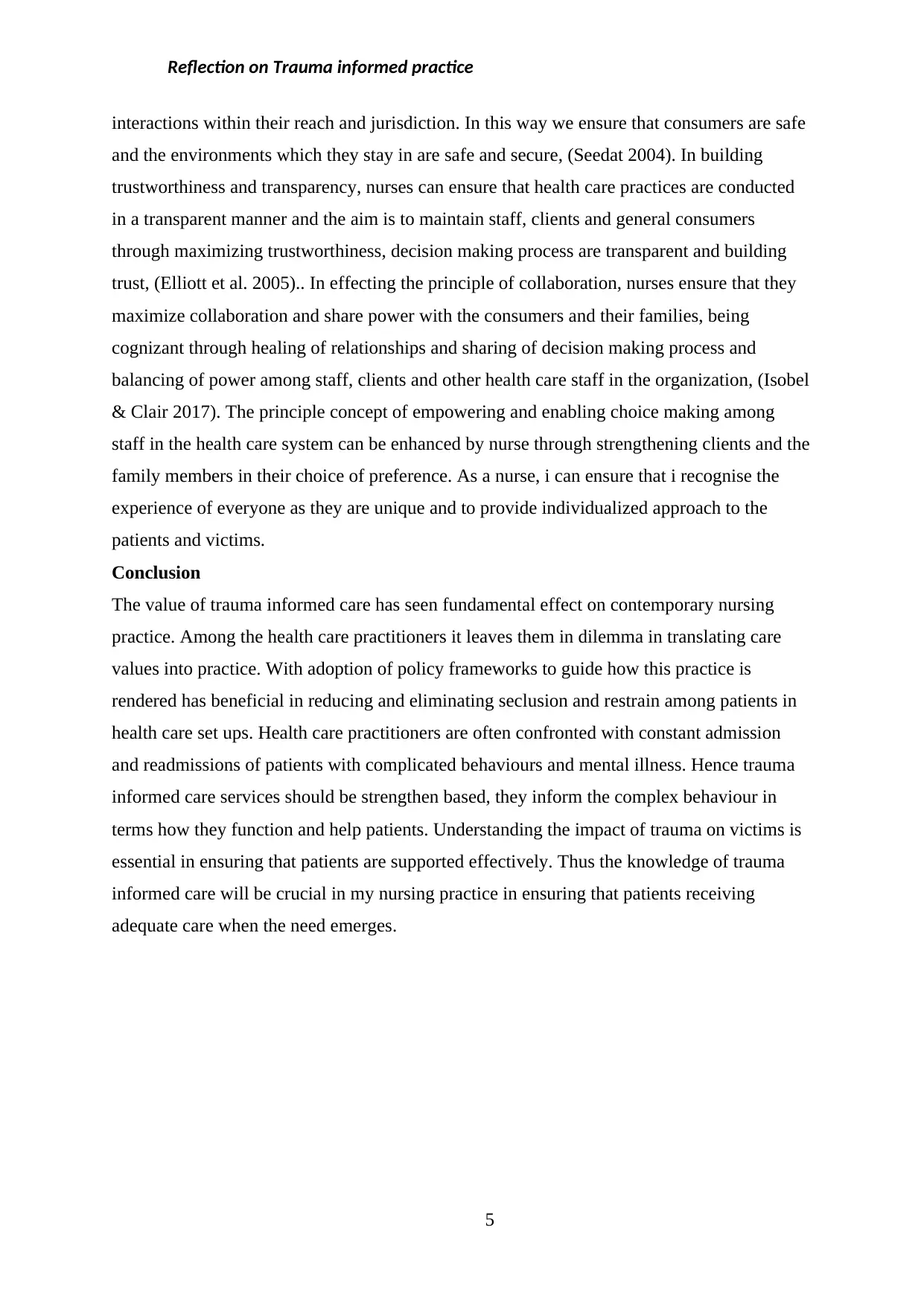
Reflection on Trauma informed practice
interactions within their reach and jurisdiction. In this way we ensure that consumers are safe
and the environments which they stay in are safe and secure, (Seedat 2004). In building
trustworthiness and transparency, nurses can ensure that health care practices are conducted
in a transparent manner and the aim is to maintain staff, clients and general consumers
through maximizing trustworthiness, decision making process are transparent and building
trust, (Elliott et al. 2005).. In effecting the principle of collaboration, nurses ensure that they
maximize collaboration and share power with the consumers and their families, being
cognizant through healing of relationships and sharing of decision making process and
balancing of power among staff, clients and other health care staff in the organization, (Isobel
& Clair 2017). The principle concept of empowering and enabling choice making among
staff in the health care system can be enhanced by nurse through strengthening clients and the
family members in their choice of preference. As a nurse, i can ensure that i recognise the
experience of everyone as they are unique and to provide individualized approach to the
patients and victims.
Conclusion
The value of trauma informed care has seen fundamental effect on contemporary nursing
practice. Among the health care practitioners it leaves them in dilemma in translating care
values into practice. With adoption of policy frameworks to guide how this practice is
rendered has beneficial in reducing and eliminating seclusion and restrain among patients in
health care set ups. Health care practitioners are often confronted with constant admission
and readmissions of patients with complicated behaviours and mental illness. Hence trauma
informed care services should be strengthen based, they inform the complex behaviour in
terms how they function and help patients. Understanding the impact of trauma on victims is
essential in ensuring that patients are supported effectively. Thus the knowledge of trauma
informed care will be crucial in my nursing practice in ensuring that patients receiving
adequate care when the need emerges.
5
interactions within their reach and jurisdiction. In this way we ensure that consumers are safe
and the environments which they stay in are safe and secure, (Seedat 2004). In building
trustworthiness and transparency, nurses can ensure that health care practices are conducted
in a transparent manner and the aim is to maintain staff, clients and general consumers
through maximizing trustworthiness, decision making process are transparent and building
trust, (Elliott et al. 2005).. In effecting the principle of collaboration, nurses ensure that they
maximize collaboration and share power with the consumers and their families, being
cognizant through healing of relationships and sharing of decision making process and
balancing of power among staff, clients and other health care staff in the organization, (Isobel
& Clair 2017). The principle concept of empowering and enabling choice making among
staff in the health care system can be enhanced by nurse through strengthening clients and the
family members in their choice of preference. As a nurse, i can ensure that i recognise the
experience of everyone as they are unique and to provide individualized approach to the
patients and victims.
Conclusion
The value of trauma informed care has seen fundamental effect on contemporary nursing
practice. Among the health care practitioners it leaves them in dilemma in translating care
values into practice. With adoption of policy frameworks to guide how this practice is
rendered has beneficial in reducing and eliminating seclusion and restrain among patients in
health care set ups. Health care practitioners are often confronted with constant admission
and readmissions of patients with complicated behaviours and mental illness. Hence trauma
informed care services should be strengthen based, they inform the complex behaviour in
terms how they function and help patients. Understanding the impact of trauma on victims is
essential in ensuring that patients are supported effectively. Thus the knowledge of trauma
informed care will be crucial in my nursing practice in ensuring that patients receiving
adequate care when the need emerges.
5
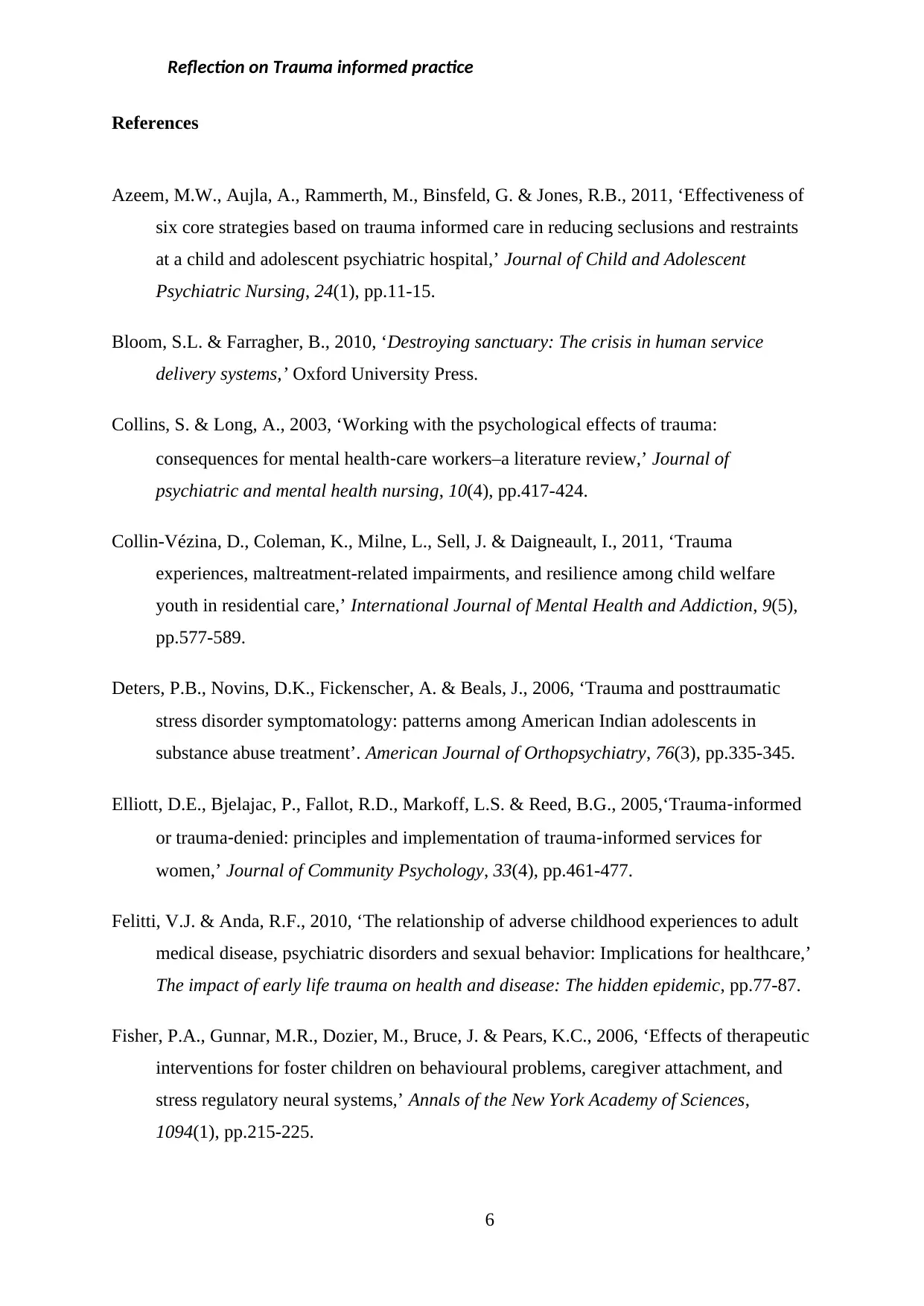
Reflection on Trauma informed practice
References
Azeem, M.W., Aujla, A., Rammerth, M., Binsfeld, G. & Jones, R.B., 2011, ‘Effectiveness of
six core strategies based on trauma informed care in reducing seclusions and restraints
at a child and adolescent psychiatric hospital,’ Journal of Child and Adolescent
Psychiatric Nursing, 24(1), pp.11-15.
Bloom, S.L. & Farragher, B., 2010, ‘Destroying sanctuary: The crisis in human service
delivery systems,’ Oxford University Press.
Collins, S. & Long, A., 2003, ‘Working with the psychological effects of trauma:
consequences for mental health‐care workers–a literature review,’ Journal of
psychiatric and mental health nursing, 10(4), pp.417-424.
Collin-Vézina, D., Coleman, K., Milne, L., Sell, J. & Daigneault, I., 2011, ‘Trauma
experiences, maltreatment-related impairments, and resilience among child welfare
youth in residential care,’ International Journal of Mental Health and Addiction, 9(5),
pp.577-589.
Deters, P.B., Novins, D.K., Fickenscher, A. & Beals, J., 2006, ‘Trauma and posttraumatic
stress disorder symptomatology: patterns among American Indian adolescents in
substance abuse treatment’. American Journal of Orthopsychiatry, 76(3), pp.335-345.
Elliott, D.E., Bjelajac, P., Fallot, R.D., Markoff, L.S. & Reed, B.G., 2005,‘Trauma‐informed
or trauma‐denied: principles and implementation of trauma‐informed services for
women,’ Journal of Community Psychology, 33(4), pp.461-477.
Felitti, V.J. & Anda, R.F., 2010, ‘The relationship of adverse childhood experiences to adult
medical disease, psychiatric disorders and sexual behavior: Implications for healthcare,’
The impact of early life trauma on health and disease: The hidden epidemic, pp.77-87.
Fisher, P.A., Gunnar, M.R., Dozier, M., Bruce, J. & Pears, K.C., 2006, ‘Effects of therapeutic
interventions for foster children on behavioural problems, caregiver attachment, and
stress regulatory neural systems,’ Annals of the New York Academy of Sciences,
1094(1), pp.215-225.
6
References
Azeem, M.W., Aujla, A., Rammerth, M., Binsfeld, G. & Jones, R.B., 2011, ‘Effectiveness of
six core strategies based on trauma informed care in reducing seclusions and restraints
at a child and adolescent psychiatric hospital,’ Journal of Child and Adolescent
Psychiatric Nursing, 24(1), pp.11-15.
Bloom, S.L. & Farragher, B., 2010, ‘Destroying sanctuary: The crisis in human service
delivery systems,’ Oxford University Press.
Collins, S. & Long, A., 2003, ‘Working with the psychological effects of trauma:
consequences for mental health‐care workers–a literature review,’ Journal of
psychiatric and mental health nursing, 10(4), pp.417-424.
Collin-Vézina, D., Coleman, K., Milne, L., Sell, J. & Daigneault, I., 2011, ‘Trauma
experiences, maltreatment-related impairments, and resilience among child welfare
youth in residential care,’ International Journal of Mental Health and Addiction, 9(5),
pp.577-589.
Deters, P.B., Novins, D.K., Fickenscher, A. & Beals, J., 2006, ‘Trauma and posttraumatic
stress disorder symptomatology: patterns among American Indian adolescents in
substance abuse treatment’. American Journal of Orthopsychiatry, 76(3), pp.335-345.
Elliott, D.E., Bjelajac, P., Fallot, R.D., Markoff, L.S. & Reed, B.G., 2005,‘Trauma‐informed
or trauma‐denied: principles and implementation of trauma‐informed services for
women,’ Journal of Community Psychology, 33(4), pp.461-477.
Felitti, V.J. & Anda, R.F., 2010, ‘The relationship of adverse childhood experiences to adult
medical disease, psychiatric disorders and sexual behavior: Implications for healthcare,’
The impact of early life trauma on health and disease: The hidden epidemic, pp.77-87.
Fisher, P.A., Gunnar, M.R., Dozier, M., Bruce, J. & Pears, K.C., 2006, ‘Effects of therapeutic
interventions for foster children on behavioural problems, caregiver attachment, and
stress regulatory neural systems,’ Annals of the New York Academy of Sciences,
1094(1), pp.215-225.
6
⊘ This is a preview!⊘
Do you want full access?
Subscribe today to unlock all pages.

Trusted by 1+ million students worldwide
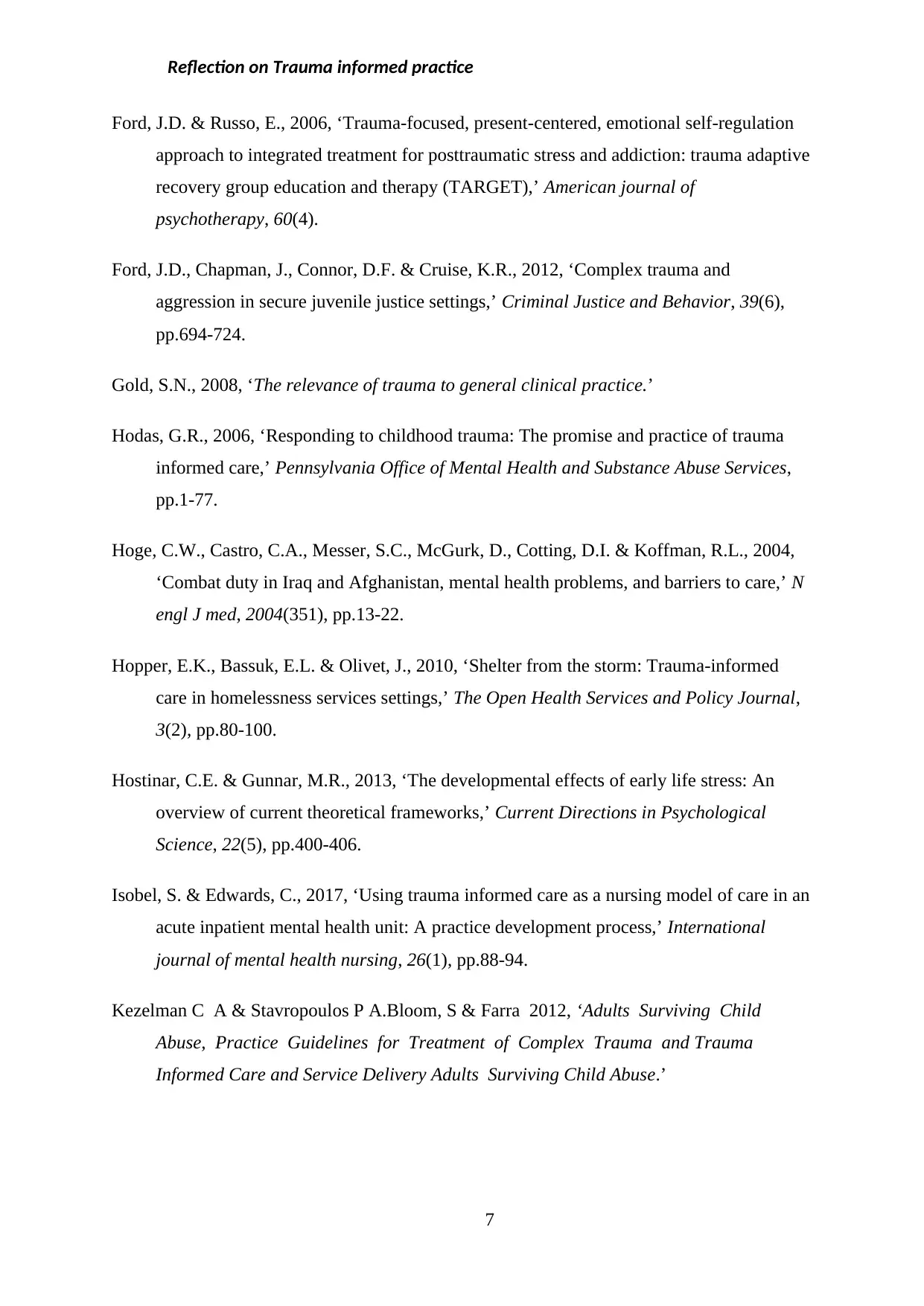
Reflection on Trauma informed practice
Ford, J.D. & Russo, E., 2006, ‘Trauma-focused, present-centered, emotional self-regulation
approach to integrated treatment for posttraumatic stress and addiction: trauma adaptive
recovery group education and therapy (TARGET),’ American journal of
psychotherapy, 60(4).
Ford, J.D., Chapman, J., Connor, D.F. & Cruise, K.R., 2012, ‘Complex trauma and
aggression in secure juvenile justice settings,’ Criminal Justice and Behavior, 39(6),
pp.694-724.
Gold, S.N., 2008, ‘The relevance of trauma to general clinical practice.’
Hodas, G.R., 2006, ‘Responding to childhood trauma: The promise and practice of trauma
informed care,’ Pennsylvania Office of Mental Health and Substance Abuse Services,
pp.1-77.
Hoge, C.W., Castro, C.A., Messer, S.C., McGurk, D., Cotting, D.I. & Koffman, R.L., 2004,
‘Combat duty in Iraq and Afghanistan, mental health problems, and barriers to care,’ N
engl J med, 2004(351), pp.13-22.
Hopper, E.K., Bassuk, E.L. & Olivet, J., 2010, ‘Shelter from the storm: Trauma-informed
care in homelessness services settings,’ The Open Health Services and Policy Journal,
3(2), pp.80-100.
Hostinar, C.E. & Gunnar, M.R., 2013, ‘The developmental effects of early life stress: An
overview of current theoretical frameworks,’ Current Directions in Psychological
Science, 22(5), pp.400-406.
Isobel, S. & Edwards, C., 2017, ‘Using trauma informed care as a nursing model of care in an
acute inpatient mental health unit: A practice development process,’ International
journal of mental health nursing, 26(1), pp.88-94.
Kezelman C A & Stavropoulos P A.Bloom, S & Farra 2012, ‘Adults Surviving Child
Abuse, Practice Guidelines for Treatment of Complex Trauma and Trauma
Informed Care and Service Delivery Adults Surviving Child Abuse.’
7
Ford, J.D. & Russo, E., 2006, ‘Trauma-focused, present-centered, emotional self-regulation
approach to integrated treatment for posttraumatic stress and addiction: trauma adaptive
recovery group education and therapy (TARGET),’ American journal of
psychotherapy, 60(4).
Ford, J.D., Chapman, J., Connor, D.F. & Cruise, K.R., 2012, ‘Complex trauma and
aggression in secure juvenile justice settings,’ Criminal Justice and Behavior, 39(6),
pp.694-724.
Gold, S.N., 2008, ‘The relevance of trauma to general clinical practice.’
Hodas, G.R., 2006, ‘Responding to childhood trauma: The promise and practice of trauma
informed care,’ Pennsylvania Office of Mental Health and Substance Abuse Services,
pp.1-77.
Hoge, C.W., Castro, C.A., Messer, S.C., McGurk, D., Cotting, D.I. & Koffman, R.L., 2004,
‘Combat duty in Iraq and Afghanistan, mental health problems, and barriers to care,’ N
engl J med, 2004(351), pp.13-22.
Hopper, E.K., Bassuk, E.L. & Olivet, J., 2010, ‘Shelter from the storm: Trauma-informed
care in homelessness services settings,’ The Open Health Services and Policy Journal,
3(2), pp.80-100.
Hostinar, C.E. & Gunnar, M.R., 2013, ‘The developmental effects of early life stress: An
overview of current theoretical frameworks,’ Current Directions in Psychological
Science, 22(5), pp.400-406.
Isobel, S. & Edwards, C., 2017, ‘Using trauma informed care as a nursing model of care in an
acute inpatient mental health unit: A practice development process,’ International
journal of mental health nursing, 26(1), pp.88-94.
Kezelman C A & Stavropoulos P A.Bloom, S & Farra 2012, ‘Adults Surviving Child
Abuse, Practice Guidelines for Treatment of Complex Trauma and Trauma
Informed Care and Service Delivery Adults Surviving Child Abuse.’
7
Paraphrase This Document
Need a fresh take? Get an instant paraphrase of this document with our AI Paraphraser
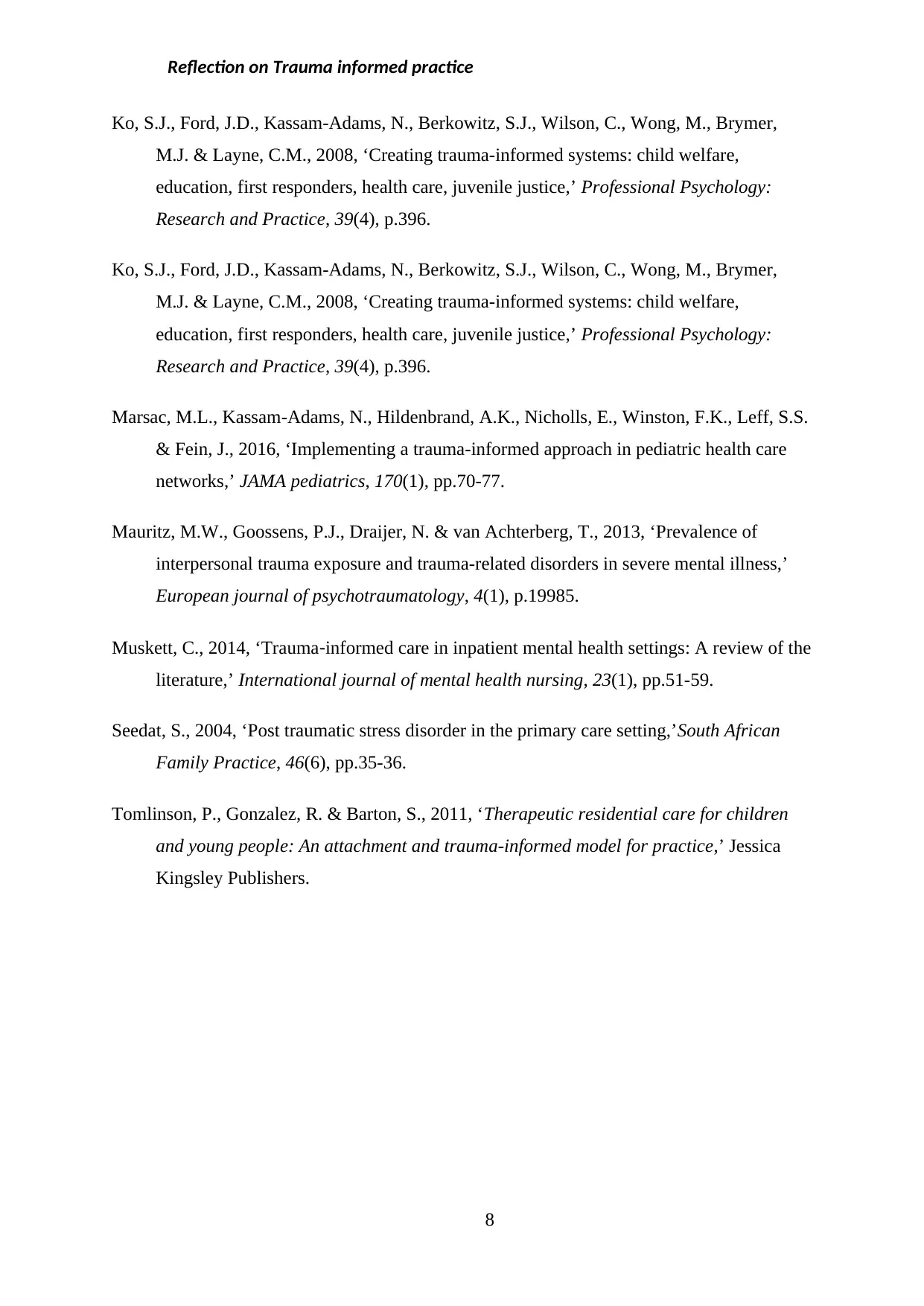
Reflection on Trauma informed practice
Ko, S.J., Ford, J.D., Kassam-Adams, N., Berkowitz, S.J., Wilson, C., Wong, M., Brymer,
M.J. & Layne, C.M., 2008, ‘Creating trauma-informed systems: child welfare,
education, first responders, health care, juvenile justice,’ Professional Psychology:
Research and Practice, 39(4), p.396.
Ko, S.J., Ford, J.D., Kassam-Adams, N., Berkowitz, S.J., Wilson, C., Wong, M., Brymer,
M.J. & Layne, C.M., 2008, ‘Creating trauma-informed systems: child welfare,
education, first responders, health care, juvenile justice,’ Professional Psychology:
Research and Practice, 39(4), p.396.
Marsac, M.L., Kassam-Adams, N., Hildenbrand, A.K., Nicholls, E., Winston, F.K., Leff, S.S.
& Fein, J., 2016, ‘Implementing a trauma-informed approach in pediatric health care
networks,’ JAMA pediatrics, 170(1), pp.70-77.
Mauritz, M.W., Goossens, P.J., Draijer, N. & van Achterberg, T., 2013, ‘Prevalence of
interpersonal trauma exposure and trauma-related disorders in severe mental illness,’
European journal of psychotraumatology, 4(1), p.19985.
Muskett, C., 2014, ‘Trauma‐informed care in inpatient mental health settings: A review of the
literature,’ International journal of mental health nursing, 23(1), pp.51-59.
Seedat, S., 2004, ‘Post traumatic stress disorder in the primary care setting,’South African
Family Practice, 46(6), pp.35-36.
Tomlinson, P., Gonzalez, R. & Barton, S., 2011, ‘Therapeutic residential care for children
and young people: An attachment and trauma-informed model for practice,’ Jessica
Kingsley Publishers.
8
Ko, S.J., Ford, J.D., Kassam-Adams, N., Berkowitz, S.J., Wilson, C., Wong, M., Brymer,
M.J. & Layne, C.M., 2008, ‘Creating trauma-informed systems: child welfare,
education, first responders, health care, juvenile justice,’ Professional Psychology:
Research and Practice, 39(4), p.396.
Ko, S.J., Ford, J.D., Kassam-Adams, N., Berkowitz, S.J., Wilson, C., Wong, M., Brymer,
M.J. & Layne, C.M., 2008, ‘Creating trauma-informed systems: child welfare,
education, first responders, health care, juvenile justice,’ Professional Psychology:
Research and Practice, 39(4), p.396.
Marsac, M.L., Kassam-Adams, N., Hildenbrand, A.K., Nicholls, E., Winston, F.K., Leff, S.S.
& Fein, J., 2016, ‘Implementing a trauma-informed approach in pediatric health care
networks,’ JAMA pediatrics, 170(1), pp.70-77.
Mauritz, M.W., Goossens, P.J., Draijer, N. & van Achterberg, T., 2013, ‘Prevalence of
interpersonal trauma exposure and trauma-related disorders in severe mental illness,’
European journal of psychotraumatology, 4(1), p.19985.
Muskett, C., 2014, ‘Trauma‐informed care in inpatient mental health settings: A review of the
literature,’ International journal of mental health nursing, 23(1), pp.51-59.
Seedat, S., 2004, ‘Post traumatic stress disorder in the primary care setting,’South African
Family Practice, 46(6), pp.35-36.
Tomlinson, P., Gonzalez, R. & Barton, S., 2011, ‘Therapeutic residential care for children
and young people: An attachment and trauma-informed model for practice,’ Jessica
Kingsley Publishers.
8
1 out of 8
Related Documents
Your All-in-One AI-Powered Toolkit for Academic Success.
+13062052269
info@desklib.com
Available 24*7 on WhatsApp / Email
![[object Object]](/_next/static/media/star-bottom.7253800d.svg)
Unlock your academic potential
Copyright © 2020–2025 A2Z Services. All Rights Reserved. Developed and managed by ZUCOL.





